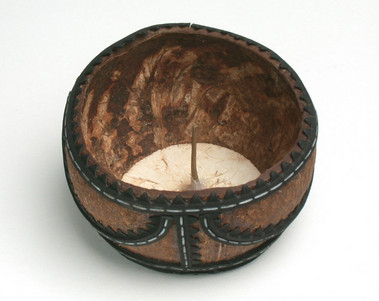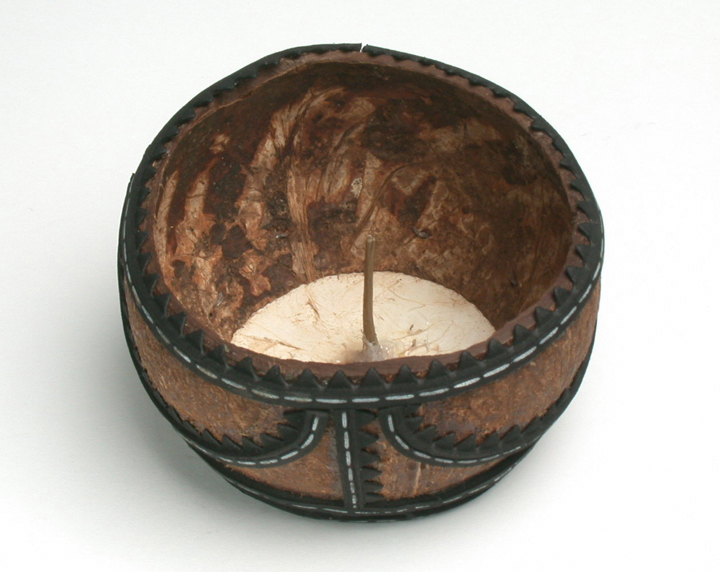Quica, Brazil
This small friction drum - its name is pronounced 'kwee-kaa' - comes from north-east Brazil. It is unique in that the sound is not made by beating the drum's head. Instead, the player rubs the stick that is fixed in the centre of the drumskin.
This quica is made from half a coconut and a small piece of goatskin which is decorated with strips of black rubber. The wooden stick, 4cm long, is fixed in the centre of the drumskin and projects inside the shell.
How the Quica is played
Has the way blacksmiths use bellows, pushing the handle with damp hands, lead to the curious way of playing this instrument? Some people think so. The quica is played with two hands, and rubbing the stick between the thumb and forefinger with a damp sponge or piece of cloth makes the sound. This makes the drum skin vibrate, producing the distinctive 'kweek kweek' sound. Putting pressure on the drum changes the pitch of the sound. The closer the player presses to the centre of the quica, the higher the sound.
This quica is made from half a coconut and a small piece of goatskin which is decorated with strips of black rubber. The wooden stick, 4cm long, is fixed in the centre of the drumskin and projects inside the shell.
How the Quica is played
Has the way blacksmiths use bellows, pushing the handle with damp hands, lead to the curious way of playing this instrument? Some people think so. The quica is played with two hands, and rubbing the stick between the thumb and forefinger with a damp sponge or piece of cloth makes the sound. This makes the drum skin vibrate, producing the distinctive 'kweek kweek' sound. Putting pressure on the drum changes the pitch of the sound. The closer the player presses to the centre of the quica, the higher the sound.

Diameter:11.5cm
Origin
Slaves from West Africa probably brought the quica to Brazil. The 'crying' sound of the drum resembles the noise made by a hyena, and the drum is sometimes referred to as the panther's roar or lion's roar. Apparently, hunters use the quica to call lions.
Sound and workings
The quica is a percussion instrument and is classed as a friction drum. The noise is made by the rubbing the stick while the drum acts as a resonator, amplifying the sound. This particular quica is a small simple instrument that may have been made for personal use or as a souvenir. It is not suitable for performances. Quicas that are played in bands are larger and usually made from more hard wearing materials. Modern quicas are also manufactured from aluminium, steel and fibreglass and they are produced in a range of sizes up to 28cm in diameter and 25cm in depth.
This quica has been made by hand using locally found natural materials and simple tools. The coconut has been hollowed out and cut in two places to form the shell. Goatskin has been stretched and across the narrower open end, then glued and nailed to the outside. Pieces of rubber cover the nails and the join where the goatskin is glued to the shell. Strips of rubber decorate the shell - these have been cut using a serrated tool to give a regular jagged edge. White broken lines are painted on to the rubber in a horizontal pattern. The wooden stick that makes the 'queeka' sound runs through the centre of the drum skin and is secured at the other side by glue and string.
The Quica and the Samba
The quica accompanies the samba, a dance that is important in Brazilian popular culture. It is part of the samba bateria where hundreds of drummers and percussionists perform as part of a group at Carnival alongside dancers, marchers and floats. Music for the samba uses no melodic instruments. Instead, percussion instruments - drums, tambourines, bells, shakers and the quica - create a vibrant, energetic soundtrack for Carnival or Mardi Gras.
Slaves from West Africa probably brought the quica to Brazil. The 'crying' sound of the drum resembles the noise made by a hyena, and the drum is sometimes referred to as the panther's roar or lion's roar. Apparently, hunters use the quica to call lions.
Sound and workings
The quica is a percussion instrument and is classed as a friction drum. The noise is made by the rubbing the stick while the drum acts as a resonator, amplifying the sound. This particular quica is a small simple instrument that may have been made for personal use or as a souvenir. It is not suitable for performances. Quicas that are played in bands are larger and usually made from more hard wearing materials. Modern quicas are also manufactured from aluminium, steel and fibreglass and they are produced in a range of sizes up to 28cm in diameter and 25cm in depth.
This quica has been made by hand using locally found natural materials and simple tools. The coconut has been hollowed out and cut in two places to form the shell. Goatskin has been stretched and across the narrower open end, then glued and nailed to the outside. Pieces of rubber cover the nails and the join where the goatskin is glued to the shell. Strips of rubber decorate the shell - these have been cut using a serrated tool to give a regular jagged edge. White broken lines are painted on to the rubber in a horizontal pattern. The wooden stick that makes the 'queeka' sound runs through the centre of the drum skin and is secured at the other side by glue and string.
The Quica and the Samba
The quica accompanies the samba, a dance that is important in Brazilian popular culture. It is part of the samba bateria where hundreds of drummers and percussionists perform as part of a group at Carnival alongside dancers, marchers and floats. Music for the samba uses no melodic instruments. Instead, percussion instruments - drums, tambourines, bells, shakers and the quica - create a vibrant, energetic soundtrack for Carnival or Mardi Gras.

Diameter:11.5cm

This small friction drum - its name is pronounced 'kwee-kaa' - comes from north-east Brazil. It is unique in that the sound is not made by beating the drum's head. Instead, the player rubs the stick that is fixed in the centre of the drumskin.
This quica is made from half a coconut and a small piece of goatskin which is decorated with strips of black rubber. The wooden stick, 4cm long, is fixed in the centre of the drumskin and projects inside the shell.
How the Quica is played
Has the way blacksmiths use bellows, pushing the handle with damp hands, lead to the curious way of playing this instrument? Some people think so. The quica is played with two hands, and rubbing the stick between the thumb and forefinger with a damp sponge or piece of cloth makes the sound. This makes the drum skin vibrate, producing the distinctive 'kweek kweek' sound. Putting pressure on the drum changes the pitch of the sound. The closer the player presses to the centre of the quica, the higher the sound.
This quica is made from half a coconut and a small piece of goatskin which is decorated with strips of black rubber. The wooden stick, 4cm long, is fixed in the centre of the drumskin and projects inside the shell.
How the Quica is played
Has the way blacksmiths use bellows, pushing the handle with damp hands, lead to the curious way of playing this instrument? Some people think so. The quica is played with two hands, and rubbing the stick between the thumb and forefinger with a damp sponge or piece of cloth makes the sound. This makes the drum skin vibrate, producing the distinctive 'kweek kweek' sound. Putting pressure on the drum changes the pitch of the sound. The closer the player presses to the centre of the quica, the higher the sound.
- Term:
- Description:
- Carnival
- The festive period before Lent, celebrated in Roman Catholic countries and communities. It is a happy occasion that goes on for two, (sometimes three or more) days, with street parades, masked balls, and public theatrical performances. Carne Vale is Latin for 'farewell to meat'. Nowadays, Carnival is also celebrated in some non-Catholic countries. In London, the Notting Hill Carnival takes place in August, when there is a better chance of good weather.
- Friction drum
- A type of drum where the sound is made by rubbing a stick attached to the head, on the inside of the instrument.
- Mardi Gras
- Carnival in New Orleans. It is one of the largest and best-known celebrations, with street music and dancing.
- Samba
- A dance from Brazil. It has two distinct forms: the urban samba, known as thesamba-carioca', a more popularized form developed in the dance-halls of Rio de Janeiro; and the rural samba, which has African influences and a complicated rhythmic structure.
- Samba bateria
- A large group of drummers and percussionists that perform in the carnival in Brazil, playing the quica, drums, bells and tambourines.
- Serrated
- Having teeth or notches on the edge.




















